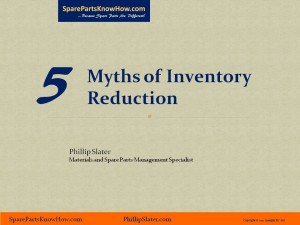 Adding an item to spare parts inventory is sometimes seen as way of spreading the cost of the item so that the original purchaser can get a lower charge to their budget. This is particularly the case with project and engineering items that have a minimum order quantity.
Adding an item to spare parts inventory is sometimes seen as way of spreading the cost of the item so that the original purchaser can get a lower charge to their budget. This is particularly the case with project and engineering items that have a minimum order quantity.
This is similar to Myth#1: Economic Quantities Save Money, except that the focus here is not on purchasing efficiencies but rather on operational or project budgets.
Ordering items where the delivery is in excess of needs and having the excess put into spare parts inventory reduces the direct cost to the immediate budget. This has the impact of appearing to save money but it does not change the actual cash cost to the company.
A mismatch between the authority to assign items to spare parts inventory and the responsibility for the inventory investment can result in inventory being used as a ‘dumping ground’ with the apparent impact of reducing operational or project costs. For the company this is a false economy.
Case Study
For a particular project a special type of electrical cable was ordered. The project only required 100m but the minimum delivery was 1,000m. The ‘excess’ 900m was transferred to inventory. The total cost of the cable was $200,000.
The project was charged $20,000 and an ‘investment’ in spare parts inventory of $180,000 was made, despite there being no further need for that cable. The project manager believed that he had saved the company money because he got the cable for his project for only $20,000.
The company had however spent $200,000 but this was not recognised because it did not appear in any profit and loss statement or project budget. Had the project been made to recognise the entire cost then perhaps a different solution would have been found.
For information on our Pro Level membership please visit our Pro Level page.
Posted by: Phillip Slater